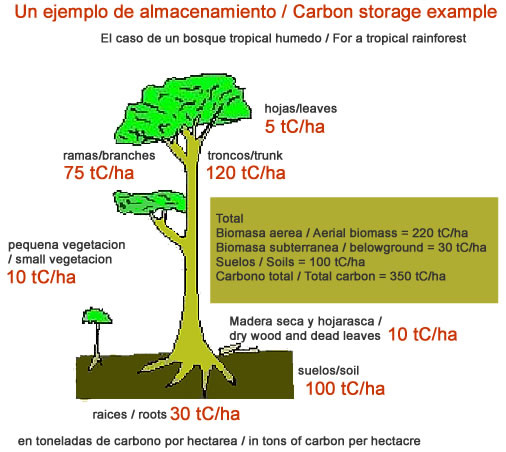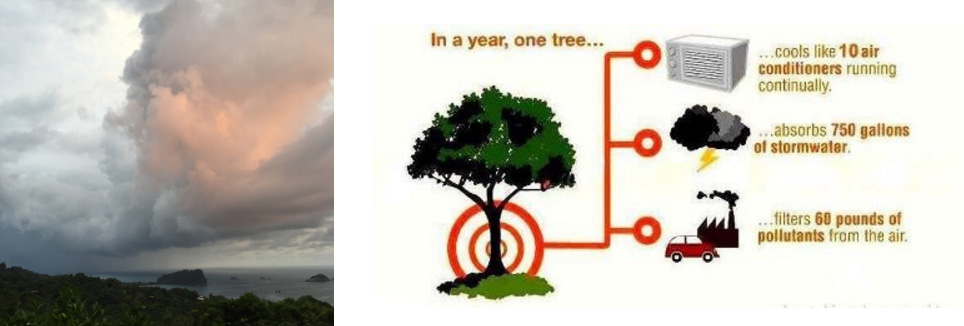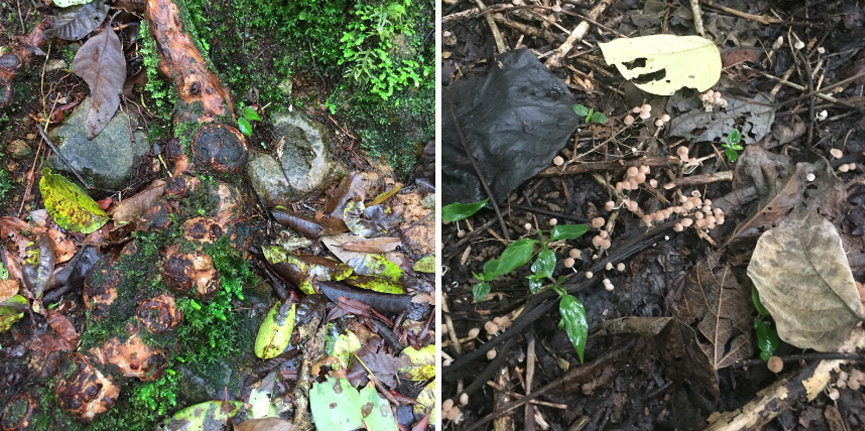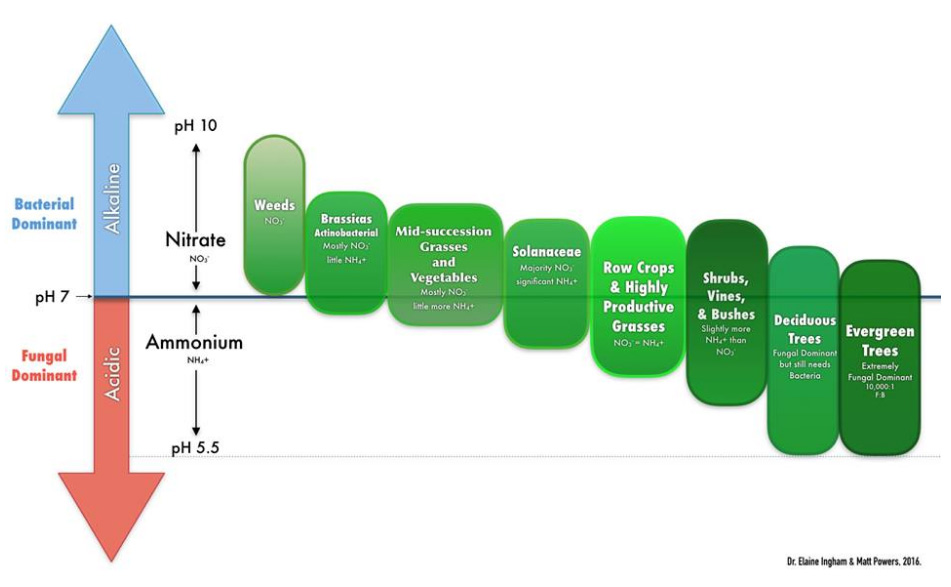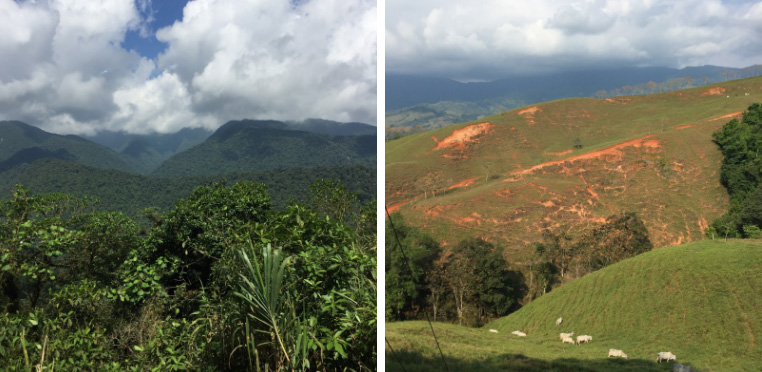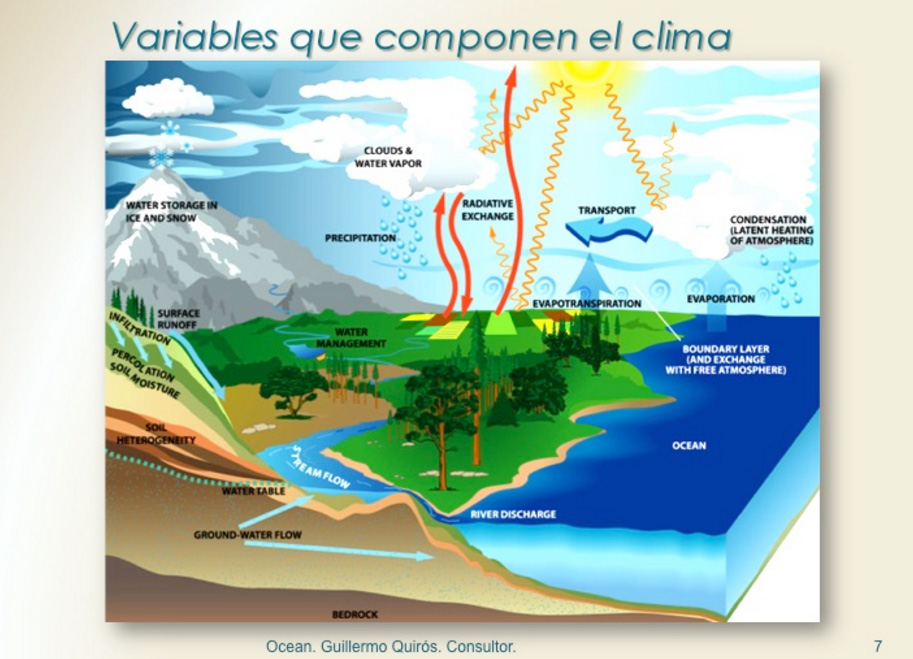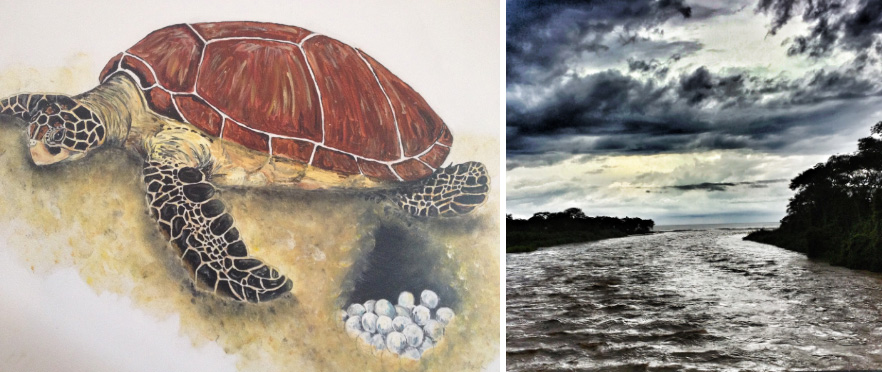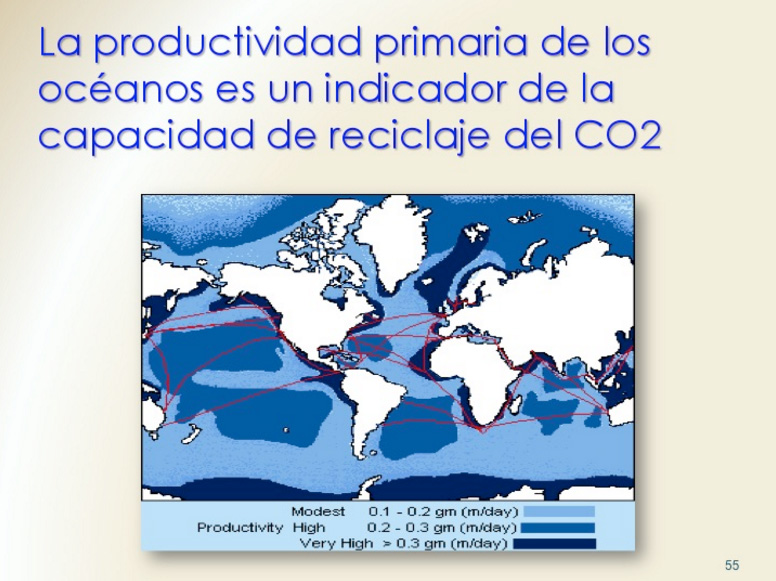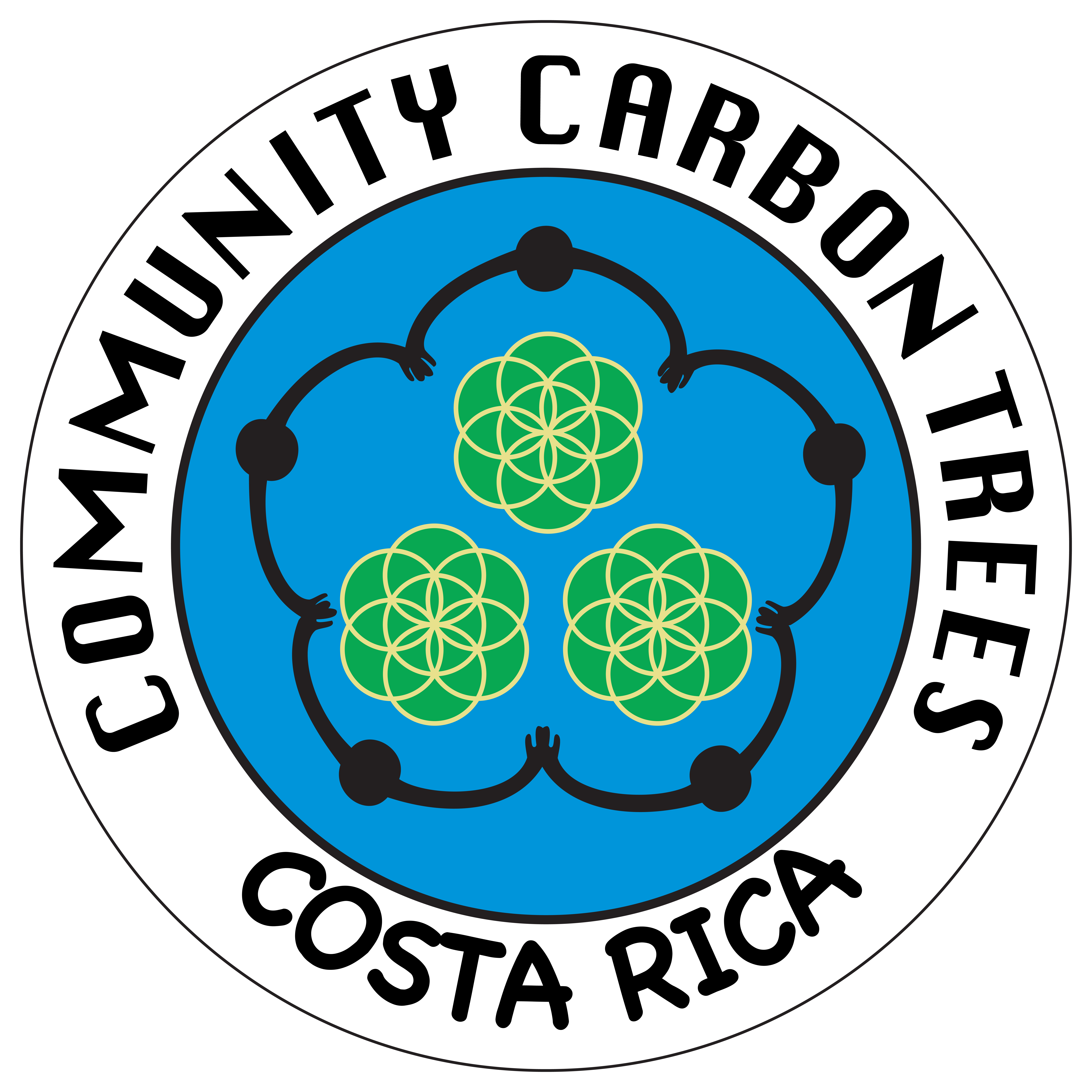

Tropical trees solution for climate change
- Tropical Rainforest Trees for Co2 Sequestration
- How Rainforest Trees Cool Earth
- Soil In The Tropical Rainforest
- Rainforest Water Cycle
- Deforestation Solutions
- Value of Trees
- How does Community Carbon Trees Help Save Primary Rainforests?
- Tropical Trees Lower Ocean Temperatures and Help Phytoplankton
Tropical Rainforest Trees for Co2 Sequestration
Planting trees in any climate is beneficial because there are many benefits of planting trees. Yet, planting trees near the equator "cools" the planet more than trees planted in temperate latitudes. Scientists from the International Panel on Climate Change have focused on tropical trees as the key to solving many global environmental and social challenges caused by climate change.
What is so magical about tropical trees? Tropical trees pull in and store 95% of all tree-based CO2 sequestration on the planet. Generally, the tropics are the areas between 23 degrees North and South of the equator. Planting trees directly recycles carbon, with new growth being the most efficient. Carbon is also sequestered through the undergrowth and roots, which move CO2 into the soil.
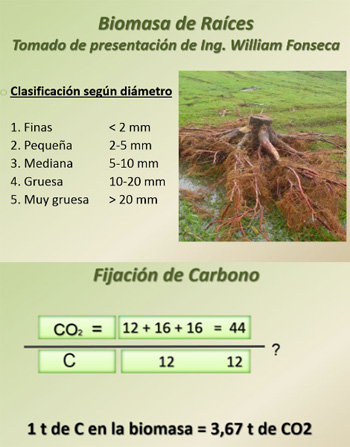
The average tropical tree sequesters a minimum of 50 lbs or 22.6 kg of carbon each year. The size and growth rate of each individual tree coupled with its specific density of biomass determines how much CO2 is pulled from the atmosphere and stored.
For example, each tree planted with Community Carbon Trees in Costa Rica sequesters one ton of CO2. One ton of CO2 is sequestered per tree over 25 years. Notably, this calculation does not account for the additional CO2 captured in the biomass or fertile topsoil, which is a beneficial byproduct of long term, high-diversity tropical tree planting.
When considering growth rates of tropical trees versus their northern boreal counterparts, the woody biomass of a tropical trees is significantly denser. Indeed, the majority of trees in the tropics are hardwoods with more than 3500 different species in Costa Rica. More than 50% of a tropical tree's woody biomass is sequestered carbon, which is why tropical trees are so important in the fight against global warming and climate change. Remember that tropical trees work 12 months of the year sequestering carbon because there is no dormant winter season. In contrast, boreal trees only work 3 months of the year. Most tropical hardwoods grow to maturity quickly (10 to 20 years), while their boreal counterparts take 80 to 120 years to achieve the same diameter as a softwood. Compare a 5 year old tropical tree to a five year old northern counterpart, and you can easily see the difference in size.
See an example and get more information about offseting carbon footprint by planting trees here.
How Rainforest Trees Cool Earth
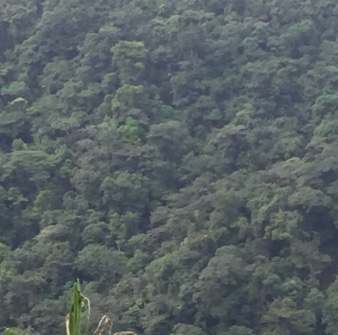
Tropical forests store large amounts of carbon dioxide and produce reflective clouds, they are especially good at cooling the planet. Forests also cool the atmosphere because they convert solar energy to water vapor, which increases sky albedo (or reflectivity) via cloud formation. This research comes from Ken Caldeira of Carnegie's Department of Global Ecology.
"Tropical forests are like Earth's air conditioner," says Caldeira. "When it comes to rehabilitating forests to fight global warming, carbon dioxide might be only half of the story; we also have to account for whether they help to reflect sunlight by producing clouds, or help to absorb it by shading snowy tundra." Forests in colder, subpolar latitudes evaporate less water and are less effective at producing clouds. As a result, the main climate effect of these forests is to increase the absorption of sunlight, which can overwhelm the cooling effect of carbon storage.
However, the advantage of forest cover is not so beneficial in the Northern hemisphere. Why? In contrast, forests in snowy areas can warm the Earth, instead of cool it, because their dark canopy absorbs sunlight that would otherwise be reflected back to space by a bright white covering of snow. Those of us living in the tropics can tell you about the cool cloudy days. We can literally feel the action of the forest cover cooling the atmosphere.
Soil In The Tropical Rainforest
Tropical trees deposit a huge amount of biomass into the soil in the form of leaves, seeds, branches, and other organic material. Animals and birds, microbes and fungus, epiphytes and bromeliads living in trees add even more organic material to the soil. Once the trees grow over the surrounding vegetation, usually dense cattle grasses, the soil temperature lowers and organic material can begin to deposit into the soil thereby also sequestering carbon. Healthy microbes grow, fungus ferments, and soil fertility is regenerated to become capable of sustaining life.
The top six inches of rainforest soil contains countless nutrients and living systems to support life.
The nitrogen cycle is critical to soil and environmental health.
The types of vegetation planted will impact the nutrient quality of soil. If a site has very poor soil small weeds, grasses and plants (as seen in the chart below) must be planted to mend soil quality before trees can survive to maturity. This is a natural process called secession. This chart refers to temperate climate vegetation but the process is the same.
Rainforest Water Cycle
Shaded soils absorb much more rainwater into underground aquifers. How does this work? Imagine a hot skillet. What happens when water hits it? It skittles away and evaporates very quickly leaving nothing but vapor. But when the skillet is cold, the water settles and evaporates much slower. The same phenomenon happens with the process of evaporation when rainwater hits the soil, especially tropical soils that are baking under the equatorial sun. Providing protective tree shade means lower temperatures allowing the water to settle on the ground and be absorbed into the underground reservoir.
The slow evaporation process performed by trees is called "evo-transpiration" and it balances our hydrological cycle of rain and snow, prevents the extreme flooding and drought cycles. This ultimately means that tropical trees fill up your glass of drinking water by making it rain (Living Energies, Victor Shauberger, Temperature Gradients in Soils).
Each tree transpires or recycles over 200 gallons of rainwater each year. By the time the trees reach 20 years old, they have formed a canopy which transpires 20,000 gallons of water per acre per year! That is a big deal with the ongoing drought and flood conditions plaguing our planet due to deforestation and increasingly high temperatures.
Deforestation Solutions
Carbon build-up caused by deforestation can also be helped by planting tropical hardwood trees. The ever-growing world demand for wood and forest products is causing enormous destruction of natural forests. Sustainably managed forests provide an alternative supply of tropical hardwoods, easing some of the pressure to cut the primary forests. Less deforestation means less carbon dioxide released. Healthier forests also mean healthier oceans which, in turn, regulate and stabilize our global climate.
Planting diverse tropical trees on farms owned by Costa Ricans using the ACCT model of paid community labor planting biodiverse species prevents further deforestation by vulnerable rainforest communities with struggling to survive with degraded soils and no other option but to cut down remaining forests for resources. This is why it is important that people living in Central America or anywhere else in developing countries where rainforests exist on the Equator get paid a fair wage to plant and maintain biodiverse trees planted on their own land with long term forest growth management included. This is what we do at ACCT!
Intact forests store the carbon dioxide in their wood, branches, leaves and soils which means that trees take the excess carbon dioxide out of the air and stores it back into the natural world especially soils over the long term. When remaining forests are cleared or degraded, there is a net flow of carbon into the atmosphere, which accounts for more than 20% of the world's total carbon emissions. Slowing forest clearing and degradation is the main focus of the UN's methods for encouraging tropical nations to reduce emissions from deforestation.
The ACCT model of reforestation is the solution! More trees for future generations grown long term with community empowerment and education as part of the hands on process means compounding benefits for the environment, the economy, and society. Be part of our carbon offset program and be the change to solve tropical deforestation and global warming.
Value of Trees
The ecological and environmental benefits produced by a single growing tree are invaluable. What is one tree worth if allowed to grow for fifty years? A total of $196,250, according to American Forests Magazine 1996, broken down as follows:
- $62,500 in air pollution control
- $37,500 in water recycling and humidity control
- $31,500 worth of oxygen
- $31,250 in soil benefits
- $31,250 in wildlife shelter
- $2,500 worth of protein in bark and leaves consumed by wildlife
The latest statistics show that rainforest land converted to cattle operations yields the landowner $60 per acre and if timber is harvested, the land is worth $400 per acre. However, if these renewable and sustainable resources (nuts, fruits and essential oils) are harvested, the land will yield the landowner $2,400 per acre.
If managed properly, the rainforest can provide the world's need for these natural resources on a perpetual basis.
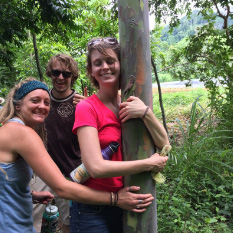
Promoting the use of these sustainable and renewable sources could stop the destruction of the rainforests. By creating a new source of income harvesting the medicinal plants, fruits nuts, oil and other sustainable resources, the rain forests is be more valuable alive than cut and burned.
Sufficient demand of sustainable and ecologically harvested rain forest products is necessary for preservation efforts to succeed. Purchasing sustainable rainforest products can effect positive change by creating a market for these products while supporting the native people's economy and provides the economic solution and alternative to cutting the forest just for the value of its timber.
Now, does it make sense to plant more trees?
How does Community Carbon Trees Help Save Primary Rainforests?
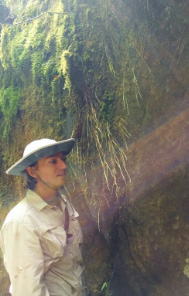
Planting and harvesting tropical hardwood trees reduces the pressure to log what little primary rainforest remains. The expanding world population coupled with the ever-growing demand for beautiful and durable hardwoods has made it crucial to provide an alternative sustainable supply of these highly desired tropical woods.
The existing rainforest will be preserved because we plant on deforested land that is otherwise unproductive, while providing local people with jobs and education. We are committed to demonstrating the profitability of sustainable forest management. In time, we hope that more of the local people will share in the wisdom of sustainably growing the world's supply of tropical hardwoods on land that has already been cleared, rather than continuing the pattern of cutting down old growth rainforest ecosystems.
We take special care to create food forests for animals and people, especially along river borders. We support local wildlife and communities with organic food and clean water. Endangered tree species are being collected and preserved for future generations. Disconnected fragments of primary forest are being joined by ACCT's planting designs to create larger intact stretches of regenerated forests for wildlife.
Tropical Trees Lower Ocean Temperatures and Help Phytoplankton
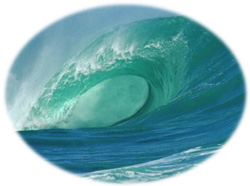
Tropical rainforests play an extra important role in working in tandem with the oceans to recycle carbon dioxide. The clouds produced by Equatorial rainforests are moved through thermohaline wind and ocean currents and serve to shade and cool off the entire planet, including the oceans. Cooler temperatures for the planet mean cooler oceans. Cooler ocean temperatures will relieve phytoplankton stressed and overwhelmed by excess carbon dioxide and record high temperatures.
Tropical trees also prevent erosion especially when planted in watersheds along deforested rivers. Tree roots hold the banks of rivers, growing in and among the rocks. Trees shade the river water and lower the water temperature which eventually drains into the downstream ocean. Tree roots form a net and keep rivers from eroding and carving into usable land and adding sediment to the oceans downstream.
Often many nitrogen rich pesticides and herbicides, not to mention huge amounts of cow poop runoff from nearby cattle farms into the downstream ocean ecosystems. All of this nitrogen from the mountains adds to acidification of the ocean and further heating of these precious ecosystems downstream. Fairly paid reforestation work on deforested pastures owned by local farmers creates new livelihoods for communities that used to depend on unsustainable business of cattle farming. Local farmers begin to use fewer chemicals and regenerate their land to healthy organic productive rainforest ecosystems sustainably managed for future generations.
Preventing erosion and sedimentation of the ocean environment lowers temperatures to protect marine wildlife of many kinds. On the Pacific coast of Costa Rica, sometimes called Costa Ballena (Whale Coast) the huge and rare humpback whales enjoy a breeding ground like few other places in the world. In addition, large sea turtles like the Olive Ridley turtle also threatened with extinction still exist. Dolphins, countless species of fish and amazing coral reefs in coastal areas are protected by responsibly reforesting the watershed in the mountains above. The effects of activities on the land are felt downstream in the estuaries where birds and animals thrive.
Ocean phytoplankton helps our atmosphere by sequestering large quantities of Co2. But the hotter the temperatures become and the more soil runoff that flows into the coastal areas, the harder it is for ocean plankton to do their job. Oceans acidification is absolutely related to what is happening on land nearby. Healthy oceans depend on healthy land practices in the surrounding area. Let's change the tide and cool off and clean up our oceans, so important to life on Earth by using tropical reforestation as an effective tool to help our ailing planet.







